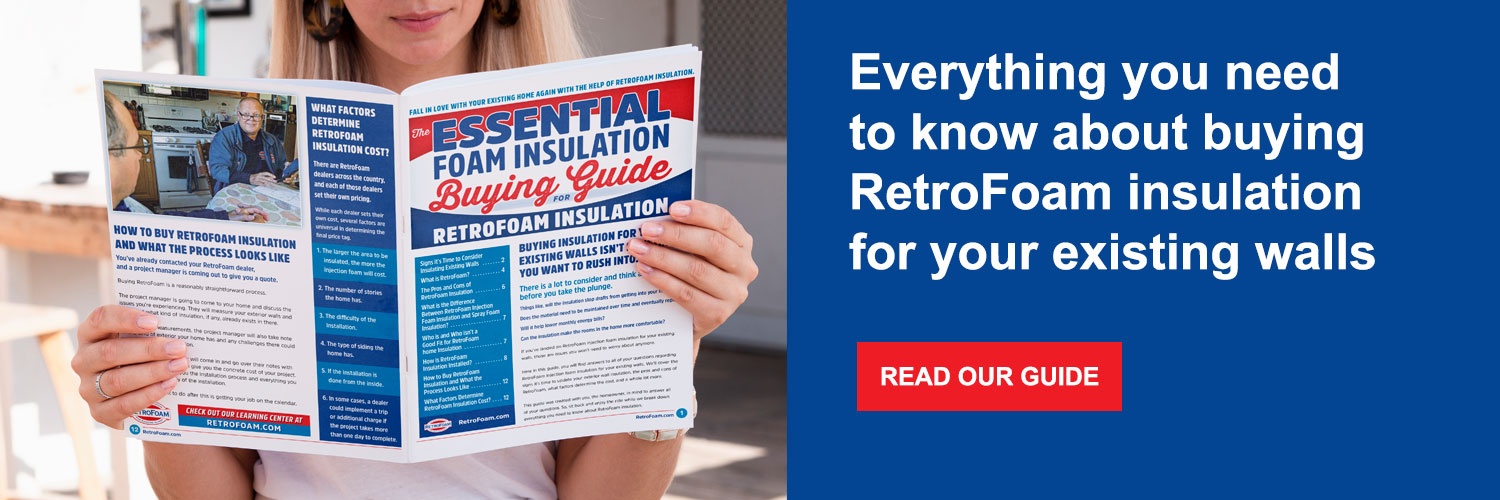Ten Home Problems That May Warrant Adding RetroFoam Insulation to Exterior Walls
RetroFoam insulation | cheap home insulation | home insulation problems | energy efficiency | foam university


Many issues can pop up when you need insulation in a home, specifically in your exterior walls.
These signs can all lead to some very annoying problems, and honestly, it only takes one of these to make you and your family miserable. From your home’s health to uncomfortable rooms, there are 10 signs you need more insulation.
RetroFoam insulation can help cure these symptoms of little to no insulation in the exterior walls of your home.
Let’s take a look at what those signs are and how RetroFoam can help.
Signs You Should Be Adding Insulation to Exterior Walls
Do exterior walls need insulation?
Absolutely.
Little to no insulation or underperforming existing insulation in your walls can make your home uncomfortable, not energy efficient, and lead to several other problems. Here are the signs that adding RetroFoam to your existing walls is a good idea.
You Have High Energy Bills
High energy bills could indicate that your wall insulation isn’t working the way you want it to.
This problem is also linked to two other signs you need insulation – uncomfortable rooms and the air conditioner and furnace running constantly. This is because you try to remedy being uncomfortable with controlling the temperature. More on this in a moment.
Uncomfortable Rooms
The rooms of your home are either too hot in the summer or too cold in the winter.
A lack of an air seal in your exterior walls can be the culprit. Air is free to move through the wall and old insulation if there is any. Not only is outdoor air seeping into your house, but the air you’re paying to heat or cool is also leaking out.
This is why this symptom contributes to the high energy bills mentioned above.
Furnace and Air Conditioner Run Constantly
Your furnace and AC unit running constantly can contribute to high energy bills as well.
These appliances are running all the time because of the air leakage into and out of your home. They can’t maintain a constant temperature, so they constantly try and hit the unattainable temperature mark you set.
Drafts Coming Through Electrical Outlets and Light Switches
The poor-performing insulation you currently have is allowing for air movement.
That air movement is now coming through the openings it finds around your electrical outlets and light switches. You might even be feeling drafts near the bottom of the wall where your baseboards are.
Condensation and Mold on the Walls
It is bad news bears if you see condensation or mold on your walls.
When there is a drastic temperature difference between your home and the outdoors when those two temperatures meet, there is the invitation for condensation to form.
Once you have that condensation, mold will begin to form in the old fiberglass or cellulose. RetroFoam stops the two temperatures from meeting, so you don’t have to worry about condensation or the growth of mold and mildew.
RetroFoam also doesn’t promote the growth of mold in the first place.
Walls are Cold to the Touch
The cold winter air has made it inside your home, and now your walls are cold to the touch.
If you are to the point that you can feel that cold through the walls, it contributes to your uncomfortable home. Stopping that air movement is the only way to prevent this.
Dishes are Always Ice Cold
If your exterior walls feel cold, then everything they come in contact with will also be cold.
This includes your kitchen cabinets and the dishes inside. No one wants to grab an ice-cold plate for their piping hot dinner.
Current Wall Insulation is More Than 15-Years-Old
Fiberglass and cellulose are known to break down, shift, settle, and sag as time goes on.
This kind of breakdown affects the material’s ability to insulate, leaving your walls with inadequate coverage. This will contribute to all of the issues listed above.
Your Wall Insulation Has Become a Critter Condo
Mice, squirrels, bats, and other pests like to make their homes out of fiberglass and cellulose.
Most people think this only happens in the attic or basement, but it can happen in your walls as well. Not only is it a health concern to have pest droppings in your walls, but these critters also affect the coverage of the insulation as they pull and scratch it around.
RetroFoam isn’t an inviting material for these pests to try and nest in.
Allergies Are a Major Concern in Your Home
Allergens travel through the air, so if your exterior walls don’t have insulation coverage, then those same pollutants will get inside.
The other issue is if you have fiberglass or cellulose, as allergens will be retained in those materials.
The air seal created by RetroFoam insulation prevents this from happening, making your home a healthier space.
Adding Foam Insulation in Existing Walls
If you’re still asking yourself, “Do I need insulation in my walls?” the answer is a resounding “yes.”
Adding RetroFoam injection foam insulation to your existing exterior walls will address all of the issues listed above. RetroFoam creates an air seal that solves many of the comfort, energy efficiency, and health concerns homeowners face.
If you want to learn more about what RetroFoam insulation offers, check out the Learning Center on our website.
Related Articles
How to Tell if There is Insulation in the Wall
How Much Can RetroFoam Insulation Help Me Save on Energy Bills?
About Amanda Emery
Amanda previously has worked as a breaking news and crime reporter, TV news producer, and editor. As a journalist, she has won several awards from The Society of Professional Journalists - Detroit Chapter and the Michigan Press Association. Amanda uses her experience as a journalist to write content that will help educate homeowners on foam insulation benefits. When Amanda isn’t writing, she’s spending time with her husband Chris, daughter Lilith-Maeve, and rescued huskies Danger and Wendigo. She also loves knitting, making art, and cooking.


